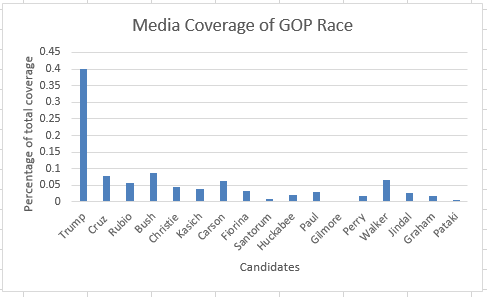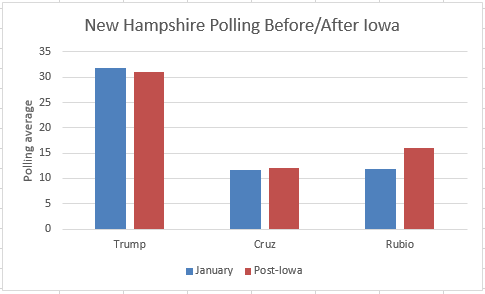In one of the defining qualities of this current 2016 GOP primary race, Donald Trump has completely dominated media coverage since the announcement of his candidacy in mid-June of 2015. This dynamic has translated to a strongly compelling reason for explaining Trump’s public opinion rise, as his candidacy and positions have constantly been made salient in the minds of GOP voters, a result that, due to the congested nature of the GOP field, has become amplified even more so.
John Sides at The Monkey Cage was one of the earliest adopters of this idea that media attention has fueled Trump’s support, revealing the strong positive relationship between coverage and poll support, and stressed this effect starting in the summer and through the fall of last year. Nate Silver brought this issue of the inseparability between media coverage of Trump and his polling strength to the fore as well. Echelon Insights also introduced an interesting “Trumpometer” that once again emphasized the importance of media in Trump’s level of support.
At the same, if Trump at any point saw a decline in media coverage–as so many other candidates typically do, and increasingly so as we get closer to actual elections when attention tends to be more evenly distributed–then a dip in polling support would coincide.
That level of unprecedented media coverage for the most part lasted well into the Iowa caucuses on February 1st. As Ted Cruz and Marco Rubio came away from this date with some sense of victory and increased media awareness, the aftermath of this first juncture of voting–and up through the New Hampshire primary on February 9th–should test the theory of media spurring Trump’s high polling numbers.
I found NewsLibrary.com, which can track news from American newspapers and television stations across certain periods of time, to be useful as a proxy for media coverage of presidential candidates (as defined by mention of their names in the lead/first paragraph of articles). From June of 2015 to the end of January 2016, the below graph demonstrates the lopsided distribution of media coverage of Republican candidates:

Comparing percentage of total candidate coverage with polling numbers by month reveals a 0.75 correlation for Trump in these categories, thus showing how critical the media has been to his public opinion support.
The week leading up to the caucuses, which could have presumably altered the tides in media coverage, did not detract much from attention towards Trump, though he did only earn about three times as much coverage as Ted Cruz in terms of total raw news (not as a percentage of all candidates).
Since the caucuses (February 2nd through about noon today), however, media coverage–at least relative to where it stood before–has endured a dramatic shift, as seen below:

A poor outcome in the Iowa caucuses relative to expectations coming in has very noticeably cut into media attention towards Trump. Cruz comes close to matching the coverage of the businessman, and Rubio has received more attention as well.
One might have expected a greater share of coverage for Rubio, who in outperforming expectations, left the Hawkeye State as essentially a victor. This measure of course marks just one source for news hits, and perhaps metrics for cable news coverage would reveal a more favorable change for Rubio.
Yet I still believe this might undercut the bounce he gets coming out of Iowa. More importantly, if the race in New Hampshire were to really change, this media coverage development would have to work in Rubio’s favor most; while Cruz saw the greatest boost coming out of Iowa, he has a fairly low ceiling in a state like New Hampshire that has much less of a religious presence a more moderate Republican base. Thus, the shifting balance of media coverage seems to have availed Rubio–the candidate with the best chance at overthrowing Trump in the Granite State–only moderately.
More polls over the next few days before the primary will offer a clearer picture, but here’s how the national race has changed going from the month of January to five days after the Iowa caucus:

And how the New Hampshire race has changed within the same time periods:

At the national level, Trump has taken a six-percentage point hit, Cruz has improved by a little over two, and most notably, Rubio experienced nearly a seven-point increase in polling strength. Note that this averages across only three polls, but this still likely captures the post-Iowa changes well.
Perhaps part of the noted bandwagon effect behind support for the Trump campaign may be starting to materialize.
Yet the New Hampshire race does not reflect this, or at least not yet. Trump and Cruz hardly changed their standings at all, while Rubio jumped just over four percentage points. For a little while this week, it seemed like Trump’s polling numbers began to creep back to the high 20’s, but the latest polls for New Hampshire–showing Trump at 34 and 35 percent–restored his greater polling cushion.
Weighted polling averages from FiveThirtyEight show a slightly larger post-Iowa bounce for Rubio; with days remaining before the New Hampshire primary, though, this may not have been enough for Rubio to really complete a comeback in the state.
Great analysis. Keep up the good work. Rudy
LikeLike